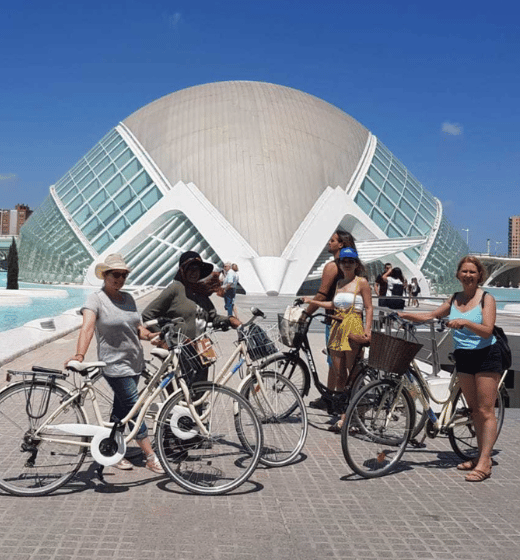

When I think about the City of Arts and Sciences, I see light, water, and shapes that don’t look real. White lines. Blue skies. Calm pools. It feels like stepping into the future without leaving Valencia.
I have walked through it many times, but it still surprises me. Sometimes I go alone. Sometimes I go with students. We stop to take photos, talk, and practise Spanish. It is a place where learning happens without trying too hard.
In this article, I will tell you what makes it special, a bit of its history, and why I think it is perfect for learning Spanish.
Introducing Valencia’s Futuristic Landmark
The Ciudad de las Artes y las Ciencias is one of the most famous places in Valencia. It is a cultural complex that feels open, bright, and full of life. You can find it in the former riverbed of the Turia River, not far from the city center.
It was designed by Valencian architect Santiago Calatrava. He is known all over Europe for his modern structures made of white concrete. Here, his style is easy to see. Long curves. Smooth lines. Reflecting pools that make the buildings look twice as big.
The place is like a small city of the future. There is an opera house, a science museum, an IMAX cinema, and even the largest aquarium in Europe. Everything is surrounded by gardens and water. It is easy to walk around, and there is even a car park close by.

The History of the City of Arts and Sciences
The idea for the City of Arts and Sciences started in the first stages of the 1990s. The city wanted something new. A place that would connect culture, science, and nature. The project was big. It would be located in the old riverbed of the River Turia, a wide space right in the heart of Valencia.
The main designer was Santiago Calatrava, with help from Félix Candela. Both created structures that looked like nothing else in the world. The construction began in 1994. Over the years, one building after another appeared. First, the Hemisfèric, then the science museum, then the Palau de les Arts. Each new site was a reason for locals to visit again.
By the time it was finished, Valencia had a new face. It was still proud of its history, but now it also had a modern side. A place for concerts, exhibitions, and family days. A place that made people say, “This is amazing.”
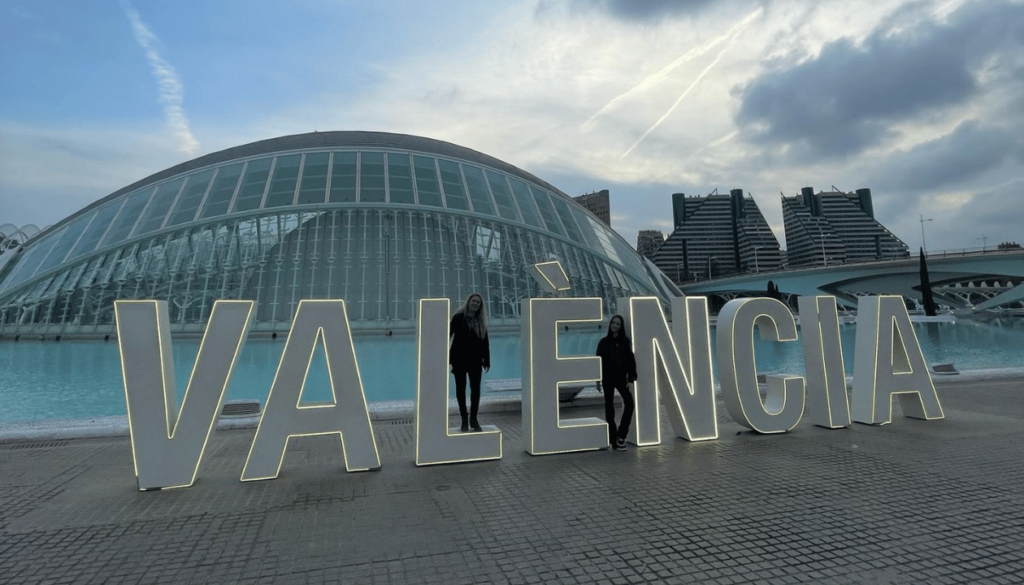
Exploring the Main Attractions
I like to take my students through the Ciutat de les Arts step by step. Each place has something special.
Hemisfèric
This building is shaped like an eye. Inside, there is an IMAX cinema and a planetarium. You can watch shows with digital projections that make you feel you are travelling through space or deep under the sea. It is one of my favourite stops during our tours.
Museu de les Ciències Príncipe Felipe
We call it the science museum. It is full of exhibitions about science and technology. You can start on the ground floor, then go up to the first floor and third floor, each one with new things to see and touch. It is a perfect place to learn new words in Spanish.
Oceanogràfic
This is the largest aquarium in Europe. Here you can see dolphins, sharks, and playful sea lions. The aquarium is divided into zones that show nature from all over the world. Many students love this part because it feels like a mini trip without leaving Valencia.
Palau de les Arts Reina Sofía
The Palau de les Arts is our opera house. It also hosts concerts and theatre. The roof is curved and elegant. At night, the lights make the structure look even more beautiful.
Ágora
The Ágora is a multifunctional space. It is used for sports, fairs, and special exhibitions. The deep blue colour is striking next to the white concrete of the other buildings.
Gardens and Surroundings
The Turia Garden runs beside the complex. It was created in the old riverbed and is perfect for walking or relaxing. There are pools that reflect the architecture, and a restaurant where you can enjoy a drink while looking at the view.
A Student’s Perspective
Many of my students have visited the Ciudad de las Artes y las Ciencias during their stay. Each one sees it in a different way, and each visit turns into a small Spanish lesson.
Sophie
Sophie came to Valencia to prepare for her IGCSE exam. One sunny morning, we went to the science museum. We explored the ground floor, then moved up to the first floor to see the space exhibition. She described planets, stars, and rockets in Spanish. At the end, we stood by the reflecting pools outside, and she gave me a short summary of her visit, all in Spanish.
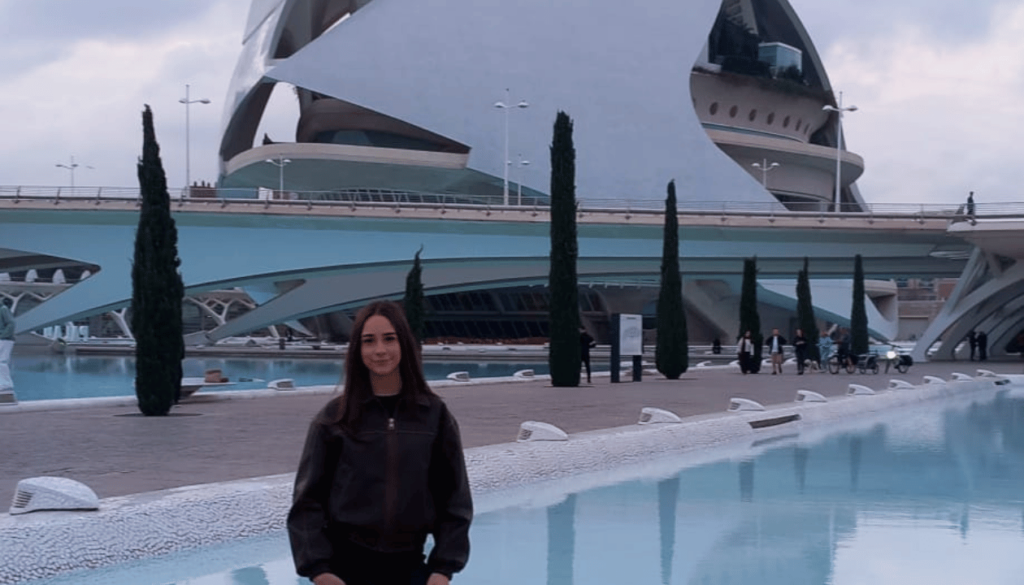
Dana
Dana’s goal was to feel more confident with everyday Spanish. We started our afternoon walking through the Turia Garden in the old riverbed of the River Turia, talking about plants and trees. Then we entered the Hemisfèric. She was amazed by the white concrete structure and how the pools made it look even bigger. We sat for a while, and she practised making polite requests in Spanish, just like she would in real life.
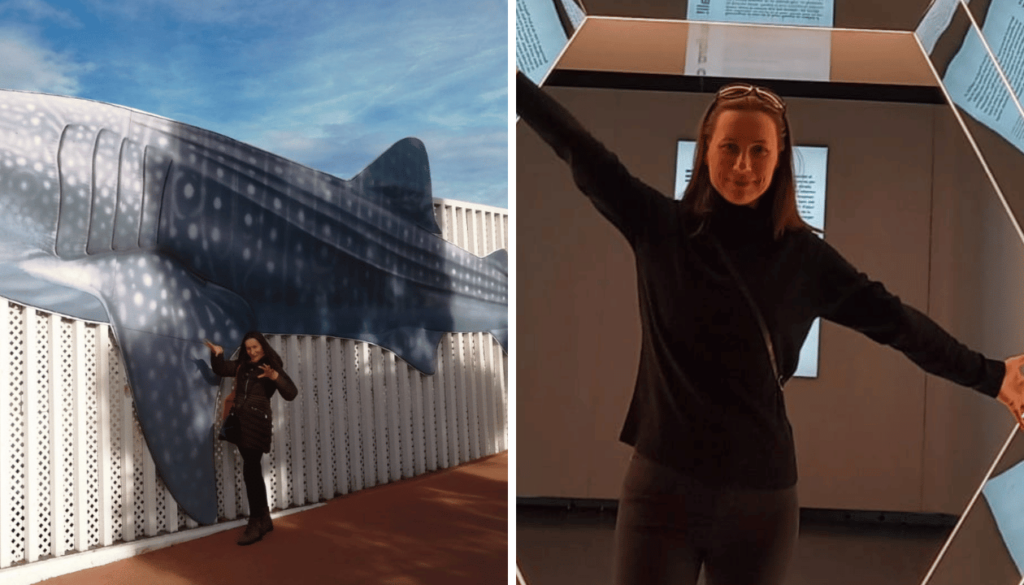
Brian
Brian wanted to improve his Spanish for travel. At the Oceanogràfic, we walked straight to the sea lions. He asked me questions in Spanish about the animals, and I helped him form longer sentences. Later, we visited the underwater tunnel. He told me, in Spanish, what he could see and how it compared to other aquariums he had visited. It became a fun trip where every word he learned was connected to a clear image.
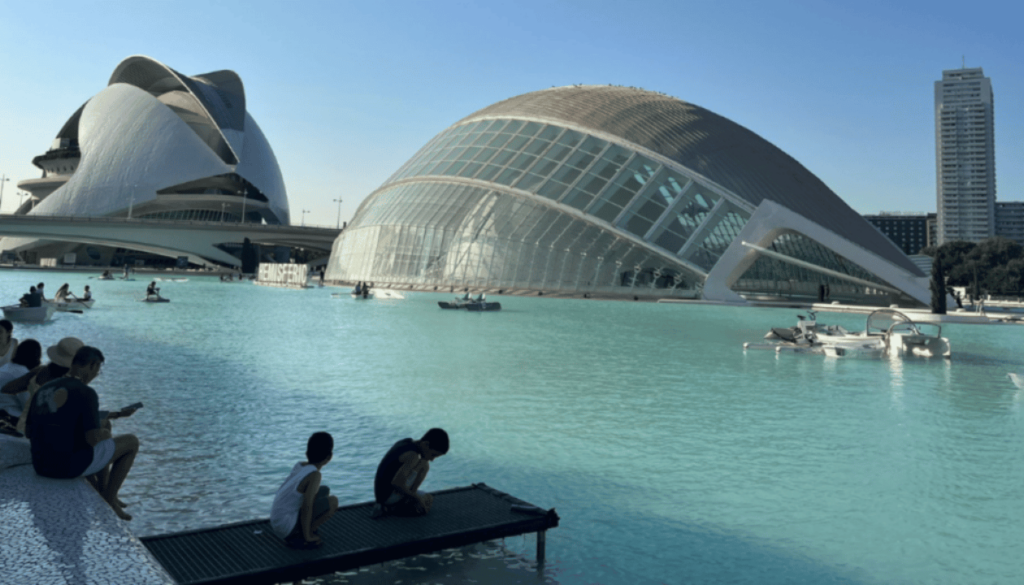
Tom
Tom was focused on his A-Level Spanish preparation. We went to the Palau de les Arts, Valencia’s opera house, and used it for a speaking task. First, he described the building, the roof, the shape, the colour and then he gave his opinion about its modern style. We finished the activity by discussing concerts and events he might attend there. It was a grammar exercise, but also a cultural one.

Christine
Christine came with a clear aim: improve her Spanish for business communication. We visited the Ágora, a multifunctional space used for fairs and events. There was an exhibition happening, so she asked for information at the ticket desk in Spanish. She listened carefully, took notes, and later explained everything to me in her own words. She said she felt proud to handle the interaction completely in Spanish without my help.
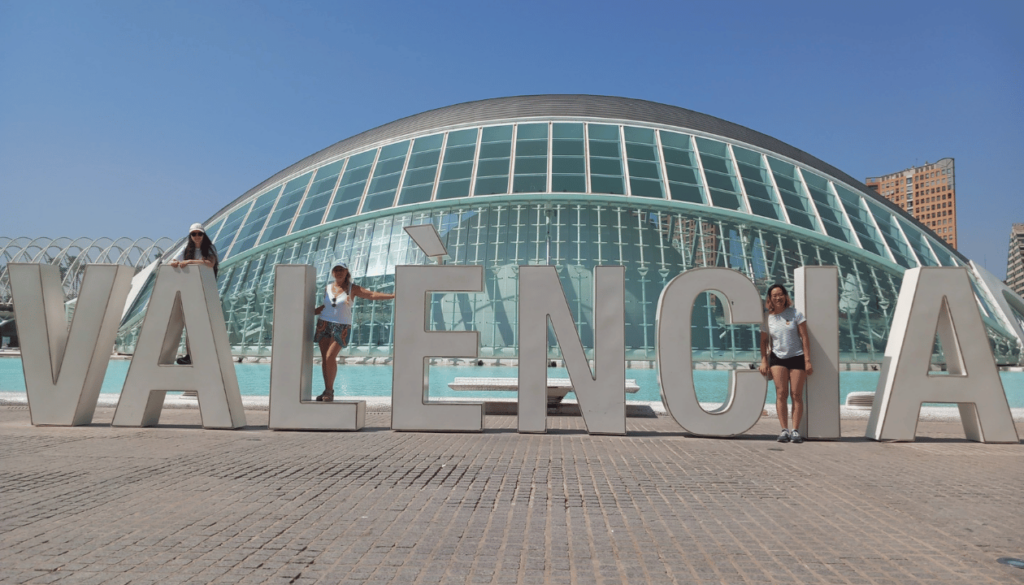
Tammi
Tammi only had one week, so every day was full. At the science museum, we explored the first and third floors, each with different topics. We practised vocabulary for the technology displays and also for the nature section. Tammi enjoyed how the museum made learning fun. At the end, she told me she could already remember new words because she could connect them to what she had seen.

Ardi
Ardi was preparing for the SIELE exam. We chose the pools outside the complex as our study spot. He had to describe the structures around him, using connectors and specific grammar points. We practised short oral tasks, like explaining the difference between two buildings or talking about the purpose of the site. He said the real location made it easier to remember the phrases for his speaking test.
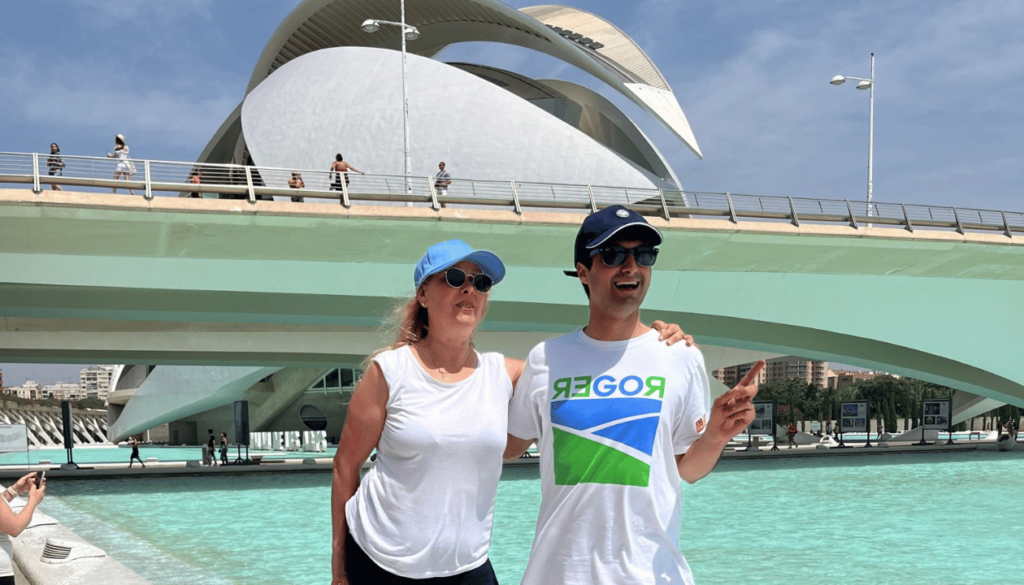
David
David, who started learning Spanish at 70, loved walking in the Turia Garden near the Ciudad de las Artes y las Ciencias. We talked about the plants, the history of the river, and how the project had changed the area. He liked the mix of nature and modern structures. Our conversation was slow but steady, and he surprised himself by remembering new words at the end of the walk.
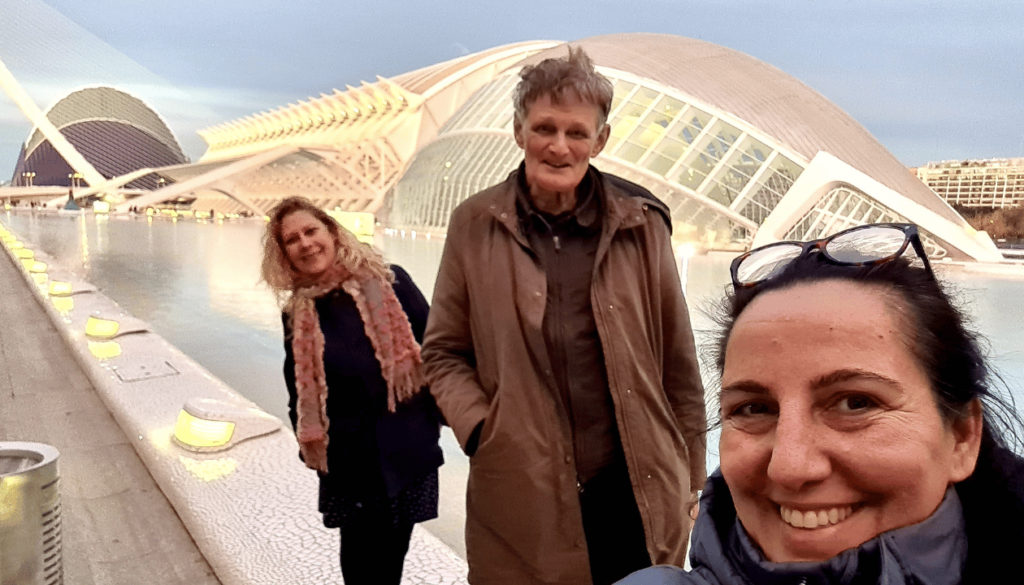
Each student leaves with new vocabulary, but more importantly, with memories they can connect to the language. That connection makes the learning last.
Why Valencia Is Perfect for Learning Spanish?
Valencia is my home, and I think it is one of the best places to learn Spanish. The city has the right size, big enough to have everything, but small enough to feel friendly. You can move easily from the city center to the beach, to the Turia Garden, or to the cultural leisure complex of the City of Arts and Sciences.
In the mornings, my students focus on Spanish lessons at home or somewhere locally. In the afternoons, we go out. One day we might explore the buildings of the complex, another day the local markets, or join one of the many festivals that fill the streets with music and colour. This mix of study and real life keeps motivation high.
Valencia also has a mild climate. Even in October, you can sit outside at a restaurant, drink a coffee, and watch the world go by. The pace is relaxed, but there is always something happening, concerts, exhibitions, and events for all ages. For those driving, there is a car park near the complex, so it’s easy to visit after class.
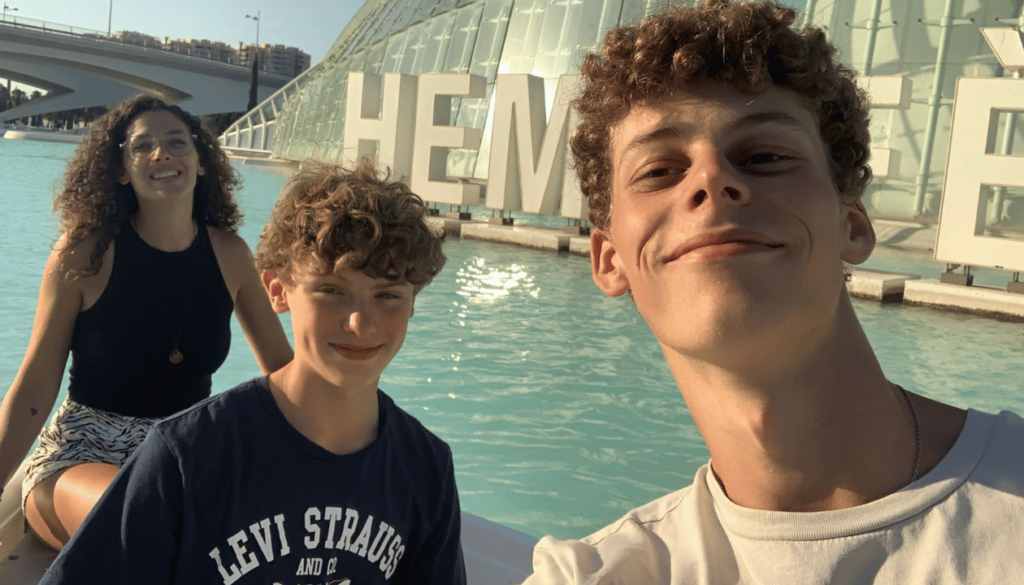
Here, learning Spanish is not just about books. It is about living in Spanish. Talking to market sellers. Asking for directions. Reading signs at the science museum. Ordering food. Every small action becomes part of the learning. That is why Valencia works so well; it lets you connect language to real experiences.
Tips for Visiting the City of Arts and Sciences
I have visited the City of Arts and Sciences many times, and each visit teaches me something new. Here are some tips so you can enjoy it fully.
Best time to visit
Mornings are quieter, and you can take your time in each building. Evenings are special too, when the lights reflect in the pools and the air is cooler.
Tickets
If you want to see more than one attraction, buy a combined ticket. It is cheaper than paying for each site separately. There are also discounts for students and families.
What to see
Do not miss the Hemisfèric with its digital projections, the science museum with its hands-on exhibitions, and the Oceanogràfic, home to dolphins and sea lions. If you like culture, the Palau de les Arts hosts concerts and opera. The Ágora is used for fairs, sports, and special events.
Getting there
The complex is well located and easy to reach from the city center. If you drive, there is a car park right next to it. You can also walk through the Turia Garden, which was created in the old riverbed of the River Turia.
Food and rest
There is a restaurant inside the complex and many cafés nearby. The outdoor spaces are nice for a break. Sit on a bench, look at the structures, and enjoy the view.
Extra tip for students
If you are here for immersion, bring a notebook. Write down new words you see on signs or hear during the visit. Later, we can review them together.
Other Destinations You Can Explore with Spanish Express
If you enjoy Valencia and the Ciudad de las Artes y las Ciencias, you might like to visit other places in Spain with us. Each city has its own style and energy, and each one is perfect for learning Spanish through our Spanish Homestay Immersion Program (SHIP).
Barcelona
Barcelona is full of art, sea views, and life. You can visit Gaudí’s famous buildings, stroll along the beach, and enjoy lively markets. With SHIP, you stay with one of our teachers — either Nanda or Mónica— in charming towns within the province of Barcelona. You study Spanish in the mornings and explore in the afternoons. We also take trips into the city center so you can experience its vibrant streets, practise your Spanish in real situations, and discover something new at every corner.

Sevilla
Sevilla is music, sunshine, and tradition. You can watch flamenco, hear guitar music in the streets, and visit historic structures like the Alcázar. In our SHIP program, mornings are for lessons at your host teacher’s home, and afternoons are for walking, tasting local food, and joining cultural events. The rhythm of the city makes learning natural and fun.

Cádiz
Cádiz has the sea on one side and history on the other. The old site is full of narrow streets, and the beaches are long and calm. With SHIP, you learn Spanish at home with your teacher, then go out to explore the city’s markets, the harbour, and the coast. It is perfect for combining language practice with time by the water.

Burgos
Burgos is a peaceful city with a beautiful Gothic cathedral and a charming old town. It is the kind of place where you can walk everywhere. In our SHIP program here, mornings are for focused lessons, and afternoons are for visiting museums, parks, and historical buildings. The slower pace gives you more time to think, speak, and connect with locals.

Extremadura
Extremadura is green, quiet, and full of hidden treasures. You will find villages, castles, and plenty of nature. With SHIP, you live with your teacher, learn Spanish over breakfast, and then explore local markets, trails, and historic structures. It is perfect if you want space, calm, and an authentic Spanish experience far from the usual tourist areas.

Your Turn to Experience It
I have shared with you my favourite place in Valencia, the City of Arts and Sciences and how it becomes a classroom without walls for my students. Now it can be yours too.
With our Spanish Homestay Immersion Program (SHIP), you live with your teacher, learn in the mornings, and explore in the afternoons. You practise Spanish in real life, not just in a book. Every visit, every walk, every meal is a chance to speak and listen.

Whether you choose Valencia, Barcelona, Sevilla, Cádiz, Burgos, or Extremadura, the experience is the same: personal, practical, and unforgettable. You learn the language, you live the culture, and you take home more than just memories.
I will be here, ready to welcome you to Valencia. Let’s make the City of Arts and Sciences part of your Spanish story.

